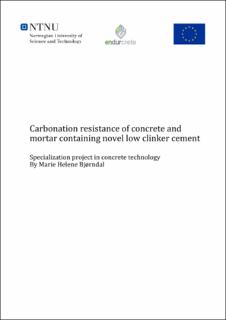Carbonation resistance of concrete and mortar containing novel low clinker cement
Student paper, others
Permanent lenke
https://hdl.handle.net/11250/2825401Utgivelsesdato
2019Metadata
Vis full innførselSamlinger
Sammendrag
Corrosion of reinforcement steel is a major deterioration mechanism for reinforced concrete structures. Corrosion can be caused by the carbonation of concrete. In this report we test the carbonation resistance of a novel low clinker cement with ground granulated blast-furnace slag (GGBFS) and limestone developed in the EnDurCrete project (CEMII/CM(S-LL)), by comparing its performance to an already commercially available blended cement (CEMII/A-S). We determine and compare the ingress of the carbonation front under accelerated laboratory conditions (1% CO2, 60% RH) on both mortar and concrete, for both cements, after 14, 28 and 90 days. We estimate the carbonation depth using two different techniques: thymolphtalein pH indicator and portlandite profiles determined by thermogravimetric analysis (TGA). In addition, we determine the relative humidity in the samples prior to exposure. The average RH for the mortar and concrete samples prior to exposure was similar. This suggests that mortar samples can be used to describe the moisture state in concrete. The RH ranged between 88 and 92%, which agrees with the level one would obtain by self-desiccation in sealed samples. The portlandite content in the non-carbonated EnDurCrete mortar is lower compared to the reference mortar, as can be expected due to the higher replacement levels with GGBFS. A lower carbonation resistance could be expected because of this, however this was not the case for the concrete samples. The carbonation depth determined by the pH indicator and the portlandite profiles agree well, taking into account the different ways of sampling for the two methods. The carbonation ingress results for mortar and concrete agree well, except for the reference mortar samples which showed a lower carbonation ingress. The reason for this is unknown. Based on the carbonation ingress results obtained on concrete, the EnDurCrete concrete exhibits a similar carbonation resistance as the reference concrete with the commercially available cement. This indicates the possibility to introduce the EnDurCrete cement as a valuable alternative to commercially available cements, providing similar properties and substantial reduction in greenhouse gases during production.
